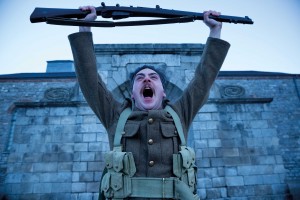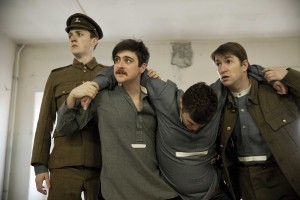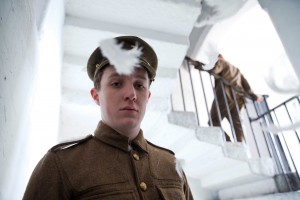PALS— The Irish at Gallipoli
Published in Issue 3 (May/June 2015), Reviews, Volume 23ANU Productions
National Museum of Ireland, Collins Barracks,
2 Feb.–30 April

The performance begins (Liam Heslin) in the courtyard of the former Royal (now Collins) Barracks, where in early 1915 D Company of the 7th Battalion of the Royal Dublin Fusiliers was stationed and trained.
In early 1915, D Company of the 7th Battalion of the Royal Dublin Fusiliers was stationed and trained in the massive Royal Barracks (now Collins Barracks) in Dublin. D Company was quite distinctive: it was a ‘pals’ unit, in which a cohort of friends, colleagues and acquaintances from a similar walk of life would enlist en masse. D Company had been organised by the IRFU, which ensured that most of its members were drawn from a similar, rugby-playing social class, and thus came to be dubbed ‘the toffs in the toughs’. The rationale behind the ‘pals’ units was that men who had strong bonds with one another outside the ranks would fight all the better for one another within them. The problem was that this vaguely idealistic notion was then pushed into the furnace of the industrial killing that characterised the Great War, and the idea was abandoned as entire communities saw generations of their menfolk decimated.
D Company was no exception. It was dispatched to the Dardanelles as part of the 10th (Irish) Division. Within a week of landing on the Gallipoli peninsula, 131 of its 220 soldiers were dead or wounded. The experience of D Company formed the subject of The pals at Suvla Bay (1917), written by Henry Hann, a veteran of the campaign, which provides some of the details encapsulated in PALS. This is the latest offering from ANU Productions and, like their previous work, is a site-specific and interactive piece, performed in the very venue where, a century previously, the soldiers whose experience it depicts trained for an experience that they could scarcely have imagined.
It begins in the courtyard, as a lecture segues into the performance in almost comedic fashion. From there it moves to one of the former barrack rooms. What follows is an intense and often unsettling experience. PALS offers a fragmented, almost impressionistic version of the prelude, experience and aftermath of the Gallipoli campaign, with intense visual and sound effects magnified within the stark confines of the barracks. It moves from barrack room banter to the horror of the trenches to the traumatised aftermath in a visceral and often unexpected fashion; it shifts back and forth in time, and the fragments of human experience in the barracks, on the battlefield and in hospitals are compressed into a bleak, if revealing, whole. Accounts of the campaign, as revealed in letters home, are dramatised, while the use of the setting adds immeasurably to the relentless atmosphere; at one point, the repetitive flicking of bereavement notices onto the floor becomes a quietly horrifying experience.

The performance moves from barrack room banter to the horror of the trenches to the traumatised aftermath in a visceral and often unexpected fashion (Kevin Olohan, Liam Heslin, Thomas Reilly and John Cronin).
PALS is of a piece with previous productions by ANU. The interactive nature of the performance, while it may not be to the taste of every member of the audience, offers a novel if unsettling means of explicating the experience of the past. It is to the credit of ANU that at no point does the production seem to preach; instead, it can prove humorous, horrifying and sometimes touching. The Irish experience of the Gallipoli campaign can be particularly neglected, but it was of great significance at the time; ANU could easily devise a production dealing with the impact of Gallipoli on the Irish ‘home front’ as much as the experience of those who fought there (even the landscape of places like Suvla Bay struck a chord with troops from Dublin, who compared it to beaches such as Dollymount and Portmarnock). But the harsh conditions took a heavy toll. The campaign had a surprising resonance in Ireland. One of the commanders at Gallipoli, Sir Ian Hamilton, was Lord Kitchener’s first choice to serve as Ireland’s military governor during the suppression of the Easter Rising, until it was pointed out that his association with Gallipoli would add insult to injury in a country and city where the human cost of the campaign was still a cause of considerable bitterness. Another link is the truth behind the patriotic assumption that Hill 16 in Croke Park was built from the rubble of the Easter Rising; the hill actually pre-dates the Rising and was originally dubbed ‘Hill 60’ after an engagement on the eponymous hill in Gallipoli in which the Dublin Fusiliers suffered heavy casualties.

A white feather was sometimes handed to men in ‘civvies’ by women, indicating contempt for those too cowardly to enlist.
(All images: ANU Productions)
Despite the commonality of experience between Irish and ANZAC troops, the manner in which they were remembered diverged wildly as the tale came to be told. For the latter, the Gallipoli campaign came to encapsulate their wartime experience, but in Ireland the struggle for independence saw the war and its individual campaigns slip down the list of potential commemorative touchstones, in a manner encapsulated in the lyrics of The Foggy Dew, with its overt statement that the men who died in Gallipoli rather than Dublin had fought the wrong fight. The centenary of the First World War has seen the reclamation of the Irish participation in the war continue apace and garner public interest. Yet a tendency to concentrate on the fact that a previously neglected topic is being remembered can seem to overshadow the events and experience being remembered; by emphasising that the Irish experience of this disastrous campaign came with horrific human cost, PALS serves as a powerful corrective to such piety. ANU Productions and the National Museum deserve great credit for developing and facilitating a production that seems to have struck a chord with the public; monthly visitor numbers to Collins Barracks were up by 42% in February 2015 and, given that performances were fully booked throughout the month, it is hard not to think that PALS played a part in this. The public appetite for explorations of the ‘decade of centenaries’ in its totality is undoubtedly there, and ANU has staked a claim to a very distinctive and successful means of exploring it. It will be very interesting to see how ANU follows up this excellent production: there is, after all, a very obvious subject to tackle in 2016.
John Gibney is editor of www.decadeofcentenaries.com.
















